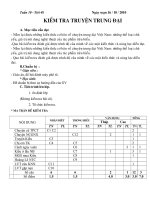17th and 18 british literature Văn học Anh thế kỉ 17 và 18
Bạn đang xem bản rút gọn của tài liệu. Xem và tải ngay bản đầy đủ của tài liệu tại đây (1.44 MB, 37 trang )
The Age of Reason
(1660 – 1798)
Instructor: Ph.D. Doan Hue Dung
Group 2:
Nguyen Thi Minh Khoa 11128046
Nguyen Thi My Kim 11128048
Tran Thi Nhu Tho 11128095
Nguyen Pham Yen Nhi 11128075
Social Background
Literature Trends
Main Writers:
•
John Dryden
•
g
•
C
•
cc
William Blake
The Age of Reason
(1660 – 1798)
Social background
A nation divided against itself, exhausted by
20 years of civil war and revolution.
Immense conflicts between Anglicanism and
Catholicism and between the monarchy and the
Parliament.
An empire: power from Canada in the west to
Indian in the east.
Leading Up to 1660
1642 16601644 1646 1648 1650 1652
1654
1656 1658
•
1653–1658 : Oliver Cromwell rules England, Scotland, and
Ireland as lord protector.
•
1660: Parliament restores Charles II to the throne.
•
1642–1651: English Civil Wars
•
1650–1651: Charles II flees to Scotland, attempts to invade
England, and escapes to France.
•
1649: Charles I is beheaded on orders of a special
Parliamentary court.
Restoration/18
Restoration/18
th
th
Century Monarchs
Century Monarchs
James II (1685-1688)
Anne (1702-1714)
George I (1714-1727)
William and Mary (1689-1702)
Restoration/18
Restoration/18
th
th
Century Monarchs
Century Monarchs
George II (1727-1760) George III (1760-
1820)
George IV (1820-1830) William IV (1830-1837)
The Restoration of the
monarchy 1660
‒ King Charles II was
restored to the throne
an admiration and
influence of French
philosophy, literature,
literary criticism and social
behavior new poetic style
The Restoration
The Restoration
During Charles II’s reign (1660–1685),
•
Church of England
•
Aristocratic courtier life: model of taste and luxury
•
Theaters reopened and censorship of the arts
declined
•
Religious persecution of Catholics + Dissenters by
Anglicans
Disaster
1665-1666: Great Plague in England
1666: Great Fire in London
1685: James II became king of England
1688: Accession of William of Orange -
William III (of Orange)
1689: William of Orange and his wife Anne
reigned England the ‘Glorious Revolution’
1707: Act of Union united Scotland and
England which become “Great Britain”
During King George III's long rule (1760-1820) Britain
became a major colonial power.
The Enlightened
•
1751: The Enlightenment movement in France
•
1660 to 1800: the Enlightenment, the Age of Reason,
the Augustan Age, the neoclassical period
Scientific rationalism, exemplified by the scientific
method.
•
This period brought many changes to
Society
Science
Religion
Literature
Society
The rich lived lavishly. They
•
attended newly reopened
theaters
•
wore expensive, heavily
ornamented clothing
•
used make-up and wore heavy
wigs (both men and women)
•
attended or hosted balls,
masquerades, and dinners in
London and in fashionable
resort cities (Bath)
Society
The poor deteriorated:
•
lived in filthy, overcrowded
slums
•
suffered from poor
sanitation and disease
•
was sent to debtors’ prisons
•
access cheap gin and had
high rates of alcoholism
Culver Pictures, Inc.
Night (18
th
century) by William Hogarth
Science
Advances in science led to a better understanding of
nature and its laws.
•
Sir Isaac Newton:
Mathematical Principles of
Natural Philosophy.
•
Robert Hooke: astronomy,
biology, chemistry, and physics.
•
Robert Boyle: the study of
chemistry.
© Bettmann/CORBIS
Sir Isaac Newton
Religion
•
Catholics and Dissenters (members of non-Anglican
Protestant churches) were persecuted.
Many Dissenters other countries for religious freedom
•
Deists, believers of a new and controversial religious
doctrine:
the universe as a perfect mechanism that God had
built and then left to run on its own.
1775: The
American
Revolution
•
1789: The
French
Revolution
Conditions of Literary Production
•
The Stage Licensing Act (1737) established a form of
dramatic censorship
•
The first British copyright law not tied to government
approval of a book's contents.
•
The term "public sphere" (coffeehouses, clubs, taverns,
parks, etc.): readers circulated and discussed the texts.
•
A greatly increased literacy rates (by 1800, 60-70
percent of adult men could read, versus 25 percent in
1600
•
Women published widely.
•
Circulating libraries began in the 1740s.
William Blake
Painter
Poet
Printmaker
William Blake
William Blake's life and time
He was born on
November 28th 1757
His education was
unorthodox
William lived in the family
home on Board Street in
Soho until he was 25
He left school at the age
of 10
William Blake's life and time
•
Blake began attending drawing classes
and at the age of 14.
imagine just for illustration
William Blake's life and time
•
Blake fed his imagination during his engraving
apprenticeship.
•
He visited Gothic churches and published his
first volume of verse called political sketches.
William Blake's life and time
•
At the age of 21, Blake became a student of
Royal Academy of Art.









